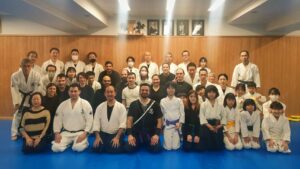
Hi, I’m Ogawa, the chief of the Aishikan Kyoto and Osaka dojo…
I often express a wish that Aishinkan Kyoto & Osaka become a third place for people, but until now, I haven’t taken the time to study about third places properly by reading books on the subject. This time, I decided to read “The Great Good Place: Cafes, Coffee Shops, Bookstores, Bars, Hair Salons, and Other Hangouts at the Heart of a Community” by Ray Oldenburg, the advocate for the importance of third places.
Though it took some courage to buy a relatively expensive book (over 4,000 yen!!), it turned out to be a great decision. The book was very insightful, and I’d like to briefly summarize its contents.
What is “Third Place”?


The term “third place” refers to spaces, separate from home (the first place) and work (the second place), that serve as important gathering spots for people in urban sociology. Examples include cafes, clubs, and parks.
Ray Oldenburg, an American sociologist, emphasizes the significance of third places, which provide individuals with a space free from the roles and responsibilities of home and work, allowing them to relax as themselves. In today’s society, where people often carry various roles at home and work, the third place becomes crucial for releasing stress and being oneself.
About the Author, Ray Oldenburg


Ray Oldenburg (Ray Oldenburg 1932 – ) is an American sociologist specializing in urban sociology.He is an emeritus professor at the University of West Florida.
He earned a Bachelor’s degree in English and Social Science from Mankato State University (now Minnesota State University, Mankato), and a Master’s and Ph.D. in Sociology from the University of Minnesota.Oldenburg criticized American society using the term “Third Place.”He positioned European cafes and pubs as Third Places, serving as vibrant hubs for community activity.
引用:Wikipedia
The Book ”Third Place”
This is a book that extensively discusses the concept of “Third Places” from the perspective of sociology, shedding light on the exchange of information and opinions, serving as a base for community activities. It’s a long-awaited Japanese translation.
Together with the first home and second workplace, urban sociology focuses on the importance of “Third Places” in supporting individual lives. In these places, individuals are liberated from the roles they play in their homes and workplaces, allowing them to relax as individuals.
The author, Oldenburg, criticizes the issues of loneliness that have arisen from the industrialization, efficiency-driven, and rationalization processes in American society and urban planning. He emphasizes the significance of “Third Places” in revitalizing local communities, with a particular focus on locally loved eateries that have been rooted in the community for a long time.
The book explores the creation of a “casual and interesting mingling among strangers,” functioning as a space for information and opinion exchange, as well as a hub for local activities. It highlights the unique characteristics of local eateries and individual shops through the lens of sociology.
In the first part, the functions, features, and physical conditions of “Third Places” are thoroughly explained. The second part introduces variations of “Third Places” based on concrete examples from places like pubs in the UK and cafes in France, showcasing the influence of culture and national characteristics. The third part discusses the challenges of “Third Places” in terms of social and political aspects and proposes solutions.
Throughout the entire book, Oldenburg’s unwavering expectations for “Third Places” are evident. The author draws on the firsthand experience of being familiar with and observing “places that are exceptionally comfortable” for many years. The book embodies the civic spirit that believes “community issues can be resolved by the power of residents.” It has been a highly anticipated Japanese translation, stimulating fields such as store design, urban planning, marketing, and community building.
引用:Amazon


The 8 Characteristics of “Third Places”


Ray Oldenburg introduces eight representative characteristics of Third Places in his book.
When I established Aikido dojos in Kyoto and Osaka, I wasn’t familiar with the term “Third Place,” but I am astonished to find that the features of Third Places align with the very essence I wanted to create in the dojos. I find it essential to revisit Ray Oldenburg’s book multiple times to thoroughly reaffirm my perspective.
1) Neutral Territory


People who come to Third Places are not there out of obligation. They come willingly because these places provide a comfortable environment, freeing them from various roles. They come joyfully, unbound by economic, political, or legal constraints.
“Individuals can come and go freely, without anyone taking on a hosting role, and everyone feels relaxed and comfortable; such a place must exist.” (※)
To maintain such a neutral place, it is important not to bring the concerns of home or work into the Third Place. A relationship based on mutual respect, with a moderate distance, is crucial for enjoying the space. The book emphasizes the importance of maintaining a moderate distance in relationships within Third Places to sustain a pleasant atmosphere.
2)Equality Among Individuals


In Third Places, social status is entirely irrelevant. Individuals in Third Places are allowed to shed all societal positions and roles, existing as individuals free from such distinctions. In other words, the people who gather in Third Places are equal.
“Equality is a source of joy and comfort for both those with high social standing in the everyday world and those with lower standing. People who, outside, assert their positions to demand obedience and attention find themselves, in the midst of Third Places, unexpectedly sought after, accepted, acknowledged, and enjoying a place where their conventional status holds little meaning. They are recognized as their true selves, accepted without being influenced by the fluctuations of political and economic life, under conditions where their true selves are embraced.”


In our dojo, we do not have designated leadership roles, except for the dojocho (head of the dojo) who takes on responsibilities. We aim to maintain a flat organizational structure.
3)Conversation as the Primary Activity


A Third Place primarily involves playful and enjoyable conversations. The tone of the conversations is casual, with a high value placed on humor, wit, and a kind-hearted playful spirit. The place is consistently filled with lively and enjoyable conversations.
“The charm of a Third Place is most distinctly represented by the delightful nature of the conversations held there—vibrant, witty, glamorous, and captivating. The joy of interaction in a Third Place might initially manifest with smiles, sparkling eyes, handshakes, or friendly pats on the back, but this joy further continues and is sustained within the realm of delightful and amusing conversations.”
The main activity at Aikido Kyoto Osaka is Aikido training, but we also want to emphasize the importance of conversations before and after the training.
4)Ease of Use and Convenience


A Third Place is an open and welcoming environment, easily accessible to many people. It is a place where individuals can go at their convenience, alone, and feel assured that they will likely encounter familiar faces.
The best Third Places offer optimal services, ensuring that people can visit almost any time, day or night, with the confidence that they will find acquaintances there.
Such spaces are essential allies for moments of loneliness, boredom, or the need to unwind in the company of good friends to alleviate the pressures and frustrations of the day.


Both Aikido dojos in Kyoto and Osaka are located in easily accessible places because of the desire to create Third Places where training takes place.
5)Presence of Regulars


Third Places have regular customers who contribute to the comfortable atmosphere of the place. Regulars are friendly and kind to new visitors. In Third Places, there are always welcoming regulars creating a pleasant atmosphere.
The charm of Third Places is not heavily influenced by factors such as the number of seats, the variety of drinks offered, the availability of parking, or the prices. What attracts regular customers to Third Places is not what the establishment provides but what the community of customers offers.
Third Places thrive when the right people bring vitality to the space, and those “right people” are the regulars. Regulars give a distinctive character to the place and ensure that there is always someone familiar whenever you visit.
6)Inconspicuous Presence


A Third Place doesn’t need flashy elements to attract attention. In most cases, it is a modest yet clean space. This allows people to come in a relaxed manner without the need for elaborate dress. The physical structure of Third Places is generally modest, often appearing plain but with a sense of cleanliness.
However, there are occasional exceptions that might not be described as entirely modest. One reason it can be challenging to convince some people of the importance of Third Places is that many of them have an unremarkable appearance. Third Places, for the most part, don’t stand out.
They are rarely, if ever, advertised, and they don’t exude a high level of sophistication. In a culture that prioritizes appearance over substance, especially with pervasive media advertising, Third Places might not make a favorable impression on first-time visitors.
7)Playful Atmosphere


Conversations in a Third Place must be cheerful and playful. This naturally brightens the atmosphere of the place, and a playful spirit is welcomed. The ambiance that constantly pervades a Third Place is filled with a sense of playfulness.
Attempting to sustain a serious conversation almost inevitably ends in failure within a minute. It’s like an invisible tightrope in the air for practicing and displaying wit, with every topic and speaker participating.


Of course, Aikido is a martial art, so etiquette is essential during practice. However, once the practice is concluded, I would like the atmosphere to be relaxed, fostering casual and enjoyable conversations.
8)A Second Home Feeling


The people in the Third Place often share warm feelings, making it feel like a temporary home. While the Third Place and one’s actual home share many similarities, the key difference lies in their nature: one is private (home) and the other is public (Third Place).
“The Third Place competes well with homes on many fronts, often emerging victorious. Some compare the Third Place with a cozy home, seeing not just similarities but also potential differences as non-threatening. Yes, that’s the tricky part— the Third Place is often, if not more often, home-like than home itself.”


Will the significance of the Third Place increase in the future?


Remote work is becoming usual even after COVID-19. It has its advantages, such as eliminating commuting and allowing for more efficient use of time. However, when the first place (home) and the second place (work) merge into one, people may feel a sense of suffocation.


I think the importance of third places becoming bigger and bigger after the settlement of COVID-19.Third places, which cannot be replaced by online alternatives, will always remain essential.


Dojo as a “Third Place”


I operate the dojo based on the philosophy of ‘enriching the lives of as many people as possible through Aikido.’ This time, by calling it the ‘most comfortable place’ at the core of the Third Place Community, I have reaffirmed the desire for Aishinkan Kyoto & Osaka to be not only a place for practicing Aikido, but also a Third Place for many people. (About Aishinkan Kyoto & Osaka)
I consider this book to be my bedside book, one that I want to revisit regularly.





コメント
コメント一覧 (1件)
I am extremely impressed together with your writing talents as smartly
as with the format in your blog. Is that this a
paid theme or did you customize it your self? Either way stay up
the excellent quality writing, it is uncommon to see a nice weblog like this one nowadays.
TikTok Algorithm!